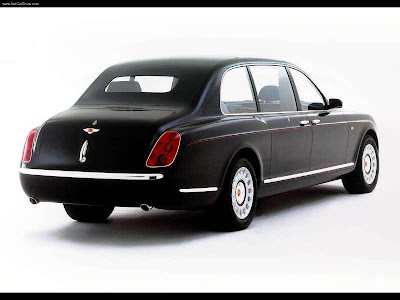Bentley Arnage T (2005)
Bentley Arnage
In 2001, the Arnage RL, a long-wheelbase limousine model, was launched. Available only as a bespoke ("Mulliner") model, each RL was customised to the desires of the buyer. The RL, however, was also the first of a new series of Arnages which would break Bentley from its BMW-rooted past permanently, as well as presenting a challenge to that company's attempt to revive Rolls-Royce sales.
The RL was larger than any contemporary limousine, notably including those from its former sister company. Wheelbases ranged from 3336 mm (131 in) to 3566 mm (140 in) and even 3844 mm (151 in), the latter two including a 100 mm (3.9 in) increase in the height of the roof. The suspension was retuned for the added weight, allowing the larger car to still handle well.
Many RL models are ordered with armoured elements, reflecting the car's clientelle. In fact, some of the "basic" car's components were armoured from the start. But a full B6 package was also available for £250,000 to £300,000, offering protection from assault weapons and grenades. The RL remains in production as of 2006.
Notable, though overlooked on the RL's introduction, was an entirely reworked engine. Where the Red Label had merely freshened the Turbo RT's engine, the RL featured an entirely reworked version of the old 6.75 L V8. More than half of the engine's parts were completely new, with Bosch Motronic ME7.1.1 engine management replacing the old Zytec system and two small Garrett T3 turbochargers replacing the single large T4. This new engine developed 400 hp (298 kW) and 616 ft·lbf (835 N·m), and was said to be capable of meeting all future emissions requirements.
In 2002, Bentley updated the Red Label as the series two Arnage R. This model was launched to contrast the Arnage T, which was developed to be more sporting. The Arnage R features two Garrett T3 turbochargers, as with the RL.
The Arnage T, also from 2002, was claimed to be the most powerful roadgoing Bentley at its launch at the Detroit Motor Show. As with the Arnage R, there were twin turbochargers, but tuned to develop 450 hp (340 kW) and 645 lbf ft (875 N·m). The Arnage T's 0–60 mph time is 5.5 s; a top speed of 168 mph (270 km/h) is claimed.
All Arnage R and T models share the same 3116 mm (122.7 in) wheelbase. The Arnage range was facelifted in 2004, with a front end resembling that of the new Continental GT.

























